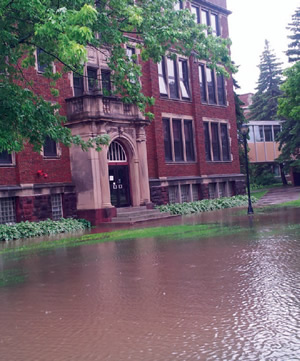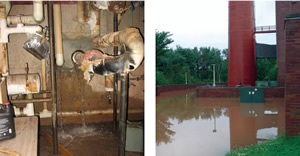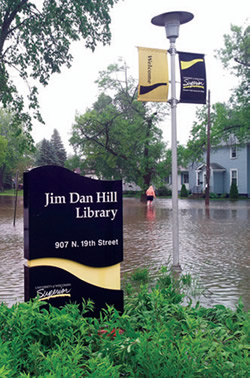After the Flood
A flood at University of Wisconsin-Superior sends administrators scrambling to plan and execute steam line insulation and vault waterproofing repairs.

PHOTOS PROVIDED BY UW-SUPERIOR
If April showers bring May flowers, then June storms bring flooding. At least, that’s what administrators at the University of Wisconsin- Superior (UW-Superior) experienced in 2012. “We received between seven and 10 inches of rain in 12 hours,” says Dusty Johnson, facilities project manager at the public university that educates 2,800 students.
All that rain was too much for back-up generators and sump pumps, and that’s when the flooding began. How bad was it? Well, the university’s heating plant includes two levels below ground, a main level and an upper level. Floodwaters filled both lower levels and reached 12 inches on the main level. “All our steam vaults, which are 3-foot by 3-foot concrete tunnels containing insulated steam lines, filled with water,” Johnson recalls. “Some other building basements were overwhelmed with water, too.”
All of the insulation around the steam lines, which had been installed in different sections between the 1940s through the 1980s and some of which contained asbestos, became wet. As things started to dry out, staff began seeing insulation in steam vault access areas, which are located wherever there are valves and or expansion joints in the steam lines. “We started shining light in those areas,” says Johnson, “and saw that insulation had dropped off the pipes.” If left uninsulated, the university’s boiler system would operate much less efficiently. And, because some of the steam pipes are located directly below sidewalks, there was even a risk that the boiler system would not be able to keep up with the increased load during Wisconsin’s long, cold winter.
Unexpected Complications
“To complicate the situation,” says Johnson, “wherever there are pipe joints, the insulation always contains asbestos. So the vaults were contaminated areas that needed abatement. That was a big deal.”
Three weeks after the flood, Johnson and his team started to excavate and reinsulate 2,000 lineal feet of the main trunk lines. “We knew it was our largest steam line so it would be our greatest loss if we did nothing,” he explains. “We also knew that, once it was repaired, we would have plenty of heating capacity to get us through the winter. We could focus on the rest of the project the following spring.”
In addition, because the lower portions of two main boilers flooded, their skins had to be repaired. This involved cutting off the skins, which were comprised of two steel plates sandwiched with asbestos-laden insulation. Then the thickness of the inner plates was tested to ensure it was good enough to be reinstalled (it was), and the sandwich was recreated with new asbestos. Finally, the skins were welded back in place.

SPEEDY RECOVERY. The majority of buildings on the University of Wisconsin–Superior campus sustained damage from floodwaters in June of 2012, especially the heating plant. Estimates put the cost of the flood at $25 million. Despite the extent of the damage, the heating plant was back up and running in three months.
Working in Phases
The rest of the project was actually broken into two phases. Phase one, which began this past May, included 2,680 lineal feet in three locations. Phase two, which will be done in May 2014, includes 1,800 lineal feet.
This spring’s project was a seven-step process. It included uncovering and exposing buried steam lines; opening the existing concrete boxes containing the steam lines for inspection of damage; removal of damaged pipe insulation; based on the inspection results, fully replacing, partially replacing/repairing or reusing the concrete box, steam piping and supports; re-insulating steam lines; closing and waterproofing the concrete boxes; and backfilling and restoring the soil and landscaping to previous conditions.
Reinsulating the concrete boxes involved power washing, then checking for cracks, which, if found, were waterproofed with caulking. Next, MEL-ROL, a rolled, selfadhering waterproofing membrane, was applied on the tops and sides. Finally, foam was applied for extra insulation and to protect the membrane against the backfill. “This is standard operation for the state of Wisconsin,” Johnson confirms.
All this work meant that most campus buildings did not have hot water, although critical buildings, such as residence halls and the Yellowjacket Union, were supplied with auxiliary hot water heaters. Also, because the project began in May, when Wisconsin temperatures can still be on the cool side, most campus buildings did not have heat. Students, staff and employees were cautioned of these two issues and bore them well.
Watching the Calendar
 Johnson notes that timing this project was the biggest challenge, as partly indicated by the lack of hot water when students were still on campus and lack of heat at a transitional time of the year when buildings are both heated and cooled. “Then, as we moved past spring,” he explains, “although we don’t have a lot of students on campus in summer, we do have some classes, and we have science research. Trying to keep all of those spaces in an appropriate temperature range was difficult.”
Johnson notes that timing this project was the biggest challenge, as partly indicated by the lack of hot water when students were still on campus and lack of heat at a transitional time of the year when buildings are both heated and cooled. “Then, as we moved past spring,” he explains, “although we don’t have a lot of students on campus in summer, we do have some classes, and we have science research. Trying to keep all of those spaces in an appropriate temperature range was difficult.”
Another challenge was the risk of a second rain event. “We had to anticipate the possibility of receiving a couple inches of rain,” Johnson says. “If this had occurred with some or all of our vaults open, we risked more flooding, both in the vaults and in the lower levels of buildings. So we wrote into the specifications that the contractor had to close the vaults at the end of every workday. You can see that there was a lot to coordinate to make the repairs and prevent additional problems.”
Obviously, because UW-Superior administrators were not planning for this natural disaster, there was no money in the coffers to pay for the repairs. Not to worry, says Johnson, the work is being covered by both insurance and FEMA funds: “Insurance is covering damage above ground and within a foundation, and FEMA is covering damage below ground and not within a foundation.
A Look at the Bright Side
“If there is an upside to the unexpected turmoil,” Johnson continues, “it’s in the details.” For example, the new insulation is foam glass, which absorbs water and dries out again. Asbestos is being eliminated throughout the entire system. And bulkheads are being installed at the buildings to keep water from pouring into the basements.
“In the long run,” Johnson says, “we wouldn’t want another flood. But it is incredible to be able to evaluate, repair and insulate the entire steam line and waterproof the vaults so that everything meets standards. Long term, we’ll be good for another 60 years. It has been difficult to do but, in the end, we are operating with a much more energy-efficient system.”
UW-Superior’s heating season begins in October. Both last year and this year, the team was able to get everything operating in time to run full loads all winter. With just 1,800 lineal feet to go next spring, they’ll surely make it a 3-0 victory.
This article originally appeared in the College Planning & Management October 2013 issue of Spaces4Learning.